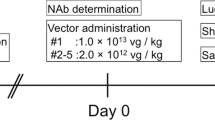Abstract
We previously showed that high and sustained transgene expression of antigenic proteins induced transgene-specific immune responses. In the present study, a detailed relationship between the level of transgene expression per cell and immune response after hydrodynamic gene transfer was investigated. Cypridina luciferase (cLuc), a secretory antigenic reporter protein, was selected as a model antigen, and pROSA-cLuc, a plasmid expressing cLuc, was constructed. A fixed dose (30 μg) of pROSA-cLuc was delivered to mice by a single hydrodynamic injection or three injections at 24-h intervals because the number of cells transfected with plasmids is dependent on the number of hydrodynamic injections. Serum cLuc activity, an indicator of the total amount of cLuc transgene expression, was almost equal between these two groups. In contrast, the high-dose single injection induced higher levels of cLuc-specific humoral and cellular immune responses than the three low-dose injections. Moreover, the serum cLuc activity of the high-dose single injection group began to decline ~10 days after injection, whereas the activity remained constant in the three low-dose injection group. These results indicate that it is preferable to reduce the level of transgene expression per cell to avoid induction of the transgene-specific immune response after hydrodynamic gene transfer.
This is a preview of subscription content, access via your institution
Access options
Subscribe to this journal
Receive 12 print issues and online access
$259.00 per year
only $21.58 per issue
Buy this article
- Purchase on Springer Link
- Instant access to full article PDF
Prices may be subject to local taxes which are calculated during checkout






Similar content being viewed by others
References
Edelstein ML, Abedi MR, Wixon J . Gene therapy clinical trials worldwide to 2007–an update. J Gene Med 2007; 9: 833–842.
Cotrim AP, Baum BJ . Gene Therapy: Some History, Applications, Problems, and Prospects. Toxicol Path 2008; 36: 97–103.
Herweijer H, Wolff JA . Progress and prospects: naked DNA gene transfer and therapy. Gene Therapy 2003; 10: 453–458.
Yin Y, Takahashi Y, Ebisuura N, Nishikawa M, Takakura Y . Removal of transgene-expressing cells by a specific immune response induced by sustained transgene expression. J Gene Med 2014; 16: 97–106.
Greenland JR, Geiben R, Ghosh S, Pastor WA, Letvin NL . Plasmid DNA vaccine-elicited cellular immune responses limit in vivo vaccine antigen expression through fas-mediated apoptosis. J Immunol 2007; 178: 5652–5658.
Zhang TP, Jin DY, Wardrop RM, Gui T, Maile R, Frelinger JA et al. Transgene expression levels and kinetics determine risk of humoral immune response modeled in factor IX knockout and missense mutant mice. Gene Therapy 2007; 14: 429–440.
Wolff LJ, Wolff JA, Sebestyén MG . Effect of tissue-specific promoters and microRNA recognition elements on stability of transgene expression after hydrodynamic naked plasmid DNA delivery. Hum Gene Therapy 2009; 20: 374–388.
Bertolino P, Trescol-Biémont MC, Rabourdin-Combe C . Hepatocytes induce functional activation of naïve CD8 T lymphocytes but fail to promote survival. Eur J Immunol 1998; 28: 221–236.
Wahl C, Bochtler P, Chen L, Schirmbeck R, Reimann J . B7-H1 on Hepatocytes Facilitates Priming of Specific CD8 T Cells But Limits the Specific Recall of Primed Responses. Gastroenterology 2008; 135: 980–988.
Watanabe T, Enomoto T, Takahashi M, Honma S, Honma K, Ohmiya Y . Multichannel perfusion culture bioluminescence reporter system for long-term detection in living cells. Anal Biochem 2010; 402: 107–109.
Wu C, Wang KY, Guo X, Sato M, Ozaki M, Shimajiri S et al. Rapid methods of detecting the target molecule in immunohistology using a bioluminescence probe. Luminescence 2013; 28: 38–43.
Tsuji FI, Sowinski R . Purification and molecular weight of Cypridina luciferase. J Cell Comp Physiol 1961; 58: 125–129.
Kobayashi N, Matsui Y, Kawase A, Hirata K, Miyagishi M, Taira K, Nishikawa M, Takakura Y . Vector-based in vivo RNA interference: dose- and time-dependent suppression of transgene expression. J Pharmacol Exp Ther 2004; 308: 688–693.
Blum JS, Wearsch PA, Cresswell P . Pathways of antigen processing. Annu Rev Immunol 2013; 31: 44–473.
Inaba K, Inaba M . Antigen recognition and presentation by dendritic cells. Int J Hematol 2005; 81: 181–187.
Amanna IJ, Slifka MK . Contributions of humoral and cellular immunity to vaccine-induced protection in humans. Virology 2011; 411: 206–215.
Potter MA, Chang PL . Review—The use of immunosuppressive agents to prevent neutralizing antibodies against a transgene product. Ann NY Acad Sci 1999; 875: 159–174.
Fields PA, Kowalczyk DW, Arruda VR, Armstrong E, McCleland ML, Hagstrom JN, Pasi KJ, Ertl HC, Herzog RW . High KA. Role of vector in activation of T cell subsets in immune responses against the secreted transgene product factor IX. Mol Ther 2000; 1: 225–235.
Acknowledgements
This work was supported in part by a Grant-in-Aid for Scientific Research (B) from the Japan Society for the Promotion of Science (grant number 24390008), and by the Research Program on Hepatitis from Japan Agency for Medical Research and development, AMED.
Author information
Authors and Affiliations
Corresponding author
Ethics declarations
Competing interests
The authors declare no conflict of interest.
Rights and permissions
About this article
Cite this article
Yin, Y., Takahashi, Y., Hamana, A. et al. Effects of transgene expression level per cell in mice livers on induction of transgene-specific immune responses after hydrodynamic gene transfer. Gene Ther 23, 565–571 (2016). https://doi.org/10.1038/gt.2016.26
Received:
Revised:
Accepted:
Published:
Issue Date:
DOI: https://doi.org/10.1038/gt.2016.26



